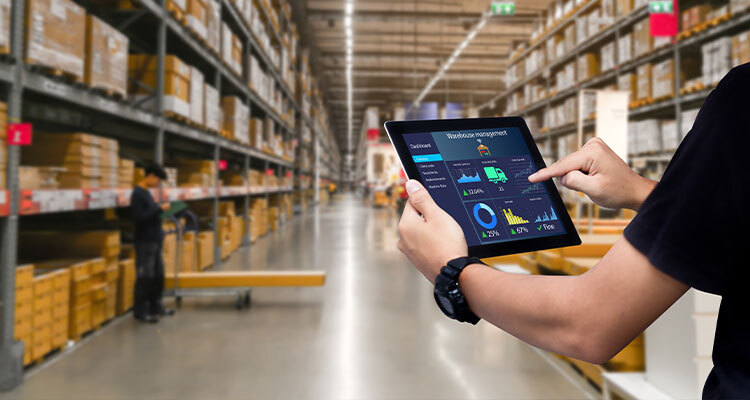
Maximising the potential of AMRs with software integration
Over the past few years, companies of every size have invested in technology to address key areas of business pain. Autonomous mobile robots (AMRs) have reduced the time spent by workers walking around the manufacturing or warehouse facility. Software solutions such as Warehouse Management Systems (WMS) have helped to optimize operations, and Pick-to-Light technology has transformed the speed and accuracy of stock picks. The result of this investment has been pockets of efficiency gains. But is this enough?
The speed of technology innovation and maturity is now opening up tangible opportunities to explore custom software development to pull these pockets of efficiency together. Whether it is joining up the AMRs with fleet management and WMS, linking WMS with Pick-to-Light or creating an optimized warehouse execution solution – companies can achieve a step-change in efficiency and further capitalize on existing investment, explains Dr Paul Rivers, CEO of Guidance Automation.

Affordable innovation
Five years ago, just a handful of Automated Guided Vehicles (AGVs) and AMRs were available for UK businesses. Today there are over 100 different vendors offering robot bases, each with different applications or functions to meet the specific needs of manufacturing and logistics operations. They are strong enough to move heavy loads; have the agility to shift goods between production lines; and are perfectly safe to operate alongside the workforce. With prices becoming ever more affordable, companies of every size are embracing these innovative solutions.
Adding AMRs to an operation is easy and delivers a fast return on investment (ROI). It doesn’t even need integration: at the simplest level, a robot can be provided with a list of activities by downloading numerous orders onto a memory stick. Even with this basic level deployment of AMRs, companies can minimize the time spent walking by staff, allowing individuals to be redeployed to other areas of the business, such as quality control. Adding robots also provides contingency – not only at peak season, but to cover shortfalls in staff due to recruitment challenges or sickness.
But why stop there? Significant additional benefits can be achieved by integrating the AMRs into the operation. For example, is the business still reliant on paper-based information to prioritize the activity undertaken by both AMRs and staff? Or manually checking package size to ensure each is allocated to the correct courier? Is picking still undertaken based on written lists – either on paper or mobile devices? Linking and automating one or more of these operations can deliver significant additional productivity benefits.
Step by step
Robots typically have the option of in-built fleet management software to ensure the vehicles are moving safely and efficiently around a facility. Additional benefits can be achieved by integrating the robot – with its picking arms, barcode readers, cameras or grabbing mechanisms – with the WMS or stock management system. The creation of custom warehouse execution software provides an end-to-end integration, where jobs are automatically optimized and AMRs and human staff work seamlessly together.
This is a significant development that needs to be customized to the specific software already in place. But while this is the ultimate goal, automation does not have to be done all at once. One example of simple integration is to use buttons to direct the AMRs to the appropriate locations – for example, press one for production, press two for stores, and so on. This easy software integration with fleet management allows a company to simply automate the orchestration of the AMRs.
A more sophisticated option is to integrate the AMR fleet management software with the WMS, adding Radio Frequency ID (RFID) tags on totes, for example, to automatically guide the AMR to the correct production line, conveyor or aisle to drop off or collect goods. This releases further time for staff to concentrate on added value activity, but the efficiency of the workforce can also be enhanced by adding a Pick to Light solution. Replacing the need for individuals to check pick lists with an intuitive model that uses lights to direct the robot to the next item to be picked, can improve the speed of picking threefold. It transforms accuracy and enables inexperienced staff to get up to speed quickly.
Planning ahead
The speed at which industrial robots are being deployed underlines the change in attitudes and confidence. However, it is important to understand the new timescales in place: global supply chain challenges have created significant shortages in AMR availability. The twelve-month lead time on new equipment is frustrating, but it also presents organizations with an excellent opportunity to assess operational priorities.
No business is looking for upheaval during peak season, but companies need to start planning in January to put the optimal solutions in place before the next peak arrives. Using information about this year’s busy period to assess volumes and workflows will highlight the key problems that need to be addressed.
By working with a partner to understand how AMRs could replicate existing processes and where the key areas of benefit could be achieved, a company can confidently plan ahead. What is the ROI for AMRs? Would the introduction of Pick-to-Light delivery be more beneficial? How long would it take to develop software to integrate both? Is there room for a robot to move up an aisle that a human is already in? Does machinery need to be relocated to allow robots to work effectively? Planning ahead is key.
Conclusion
There are many simple wins available for companies at every stage of technology maturity. For those that have yet to embrace automation, the addition of an AMR or two can allow a business to reallocate staff to more valuable areas and help to reduce the pressure on recruiting warehouse operatives. The integration of buttons, RFID tags and lights can then be added incrementally to reflect evolving business needs.
Obviously, the more a business automates, the greater the efficiencies gained. But even the smallest automaton will deliver improvements – and deliver further benefits from the existing investment. The key is to understand the ROI opportunities and get started.
For a list of the sources used in this article, please contact the editor.
Dr Paul Rivers
www.guidanceautomation.com
Guidance Automation is the trusted provider of automation solutions for small to medium businesses, providing expertise and support to unlock their automation potential. The company’s knowledge and expertise have been developed over 30 years and its technologies are helping warehouse, distribution, fulfilment/ecommerce, manufacturing and healthcare facilities work smarter.